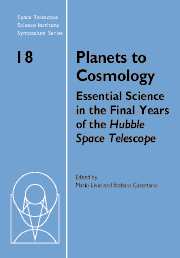 Planets to Cosmology
Planets to Cosmology Book contents
- Frontmatter
- Contents
- Participants
- Preface
- Hubble's view of transiting planets
- Unsolved problems in star formation
- Star formation in clusters
- HST abundance studies of low metallicity stars
- Physical conditions and feedback: HST studies of intense star-forming environments
- Quasar hosts: Growing up with monstrous middles
- Reverberation mapping of active galactic nuclei
- Feedback at high redshift
- The baryon content of the local intergalactic medium
- Hot baryons in supercluster filaments
- Galaxy assembly
- Probing the reionization history of the Universe
- Studying distant infrared-luminous galaxies with Spitzer and Hubble
- Galaxies at z ≈ 6–i′-drop selection and the GLARE Project
- The Hubble Ultra Deep Field with NICMOS
Probing the reionization history of the Universe
Published online by Cambridge University Press: 17 August 2009
- Frontmatter
- Contents
- Participants
- Preface
- Hubble's view of transiting planets
- Unsolved problems in star formation
- Star formation in clusters
- HST abundance studies of low metallicity stars
- Physical conditions and feedback: HST studies of intense star-forming environments
- Quasar hosts: Growing up with monstrous middles
- Reverberation mapping of active galactic nuclei
- Feedback at high redshift
- The baryon content of the local intergalactic medium
- Hot baryons in supercluster filaments
- Galaxy assembly
- Probing the reionization history of the Universe
- Studying distant infrared-luminous galaxies with Spitzer and Hubble
- Galaxies at z ≈ 6–i′-drop selection and the GLARE Project
- The Hubble Ultra Deep Field with NICMOS
Summary
We discuss currently available observational constraints on the reionization history of the intergalactic medium (IGM), and the extent to which accreting black holes (BHs) and stars can help account for these observations. We argue, based on the combined statistics of Lyman α and β absorption in quasar spectra, that the IGM contains a significant amount of neutral hydrogen with nH I/nH ≳ 0.1. On the other hand, we argue, based on the lack of a strong evolution in the observed abundance of Lyman α emitting galaxies beyond z ∼ 5.5, that the mean neutral hydrogen fraction cannot exceed nH I/nH ≈ 0.3 at the same redshift. We conclude that the IGM is experiencing rapid ionization at redshift z ∼ 6.
We find that quasar BHs, including faint ones that are individually below the detection thresholds of existing optical and X-ray surveys, are unlikely to drive the evolution of the neutral fraction around this epoch, because they would over-produce the present-day soft X-ray background. On the other hand, the seeds of the z ∼ 6 quasar BHs likely appeared at much earlier epochs (z ∼ 20), and produced hard ionizing radiation by accretion. These early BHs are promising candidates to account for the high redshift (z ∼ 15) ionization implied by the recent cosmic microwave anisotropy data from WMAP.
Using a model for the growth of BHs by accretion and mergers in a hierarchical cosmology, we suggest that the early growth of quasars must include a super-Eddington growth phase, and that, although not yet optically identified, the FIRST radio survey may have already detected several thousand > 108 M⊙ BHs at z > 6.
- Type
- Chapter
- Information
- Planets to CosmologyEssential Science in the Final Years of the Hubble Space Telescope: Proceedings of the Space Telescope Science Institute Symposium, Held in Baltimore, Maryland May 3–6, 2004, pp. 157 - 173Publisher: Cambridge University PressPrint publication year: 2006


